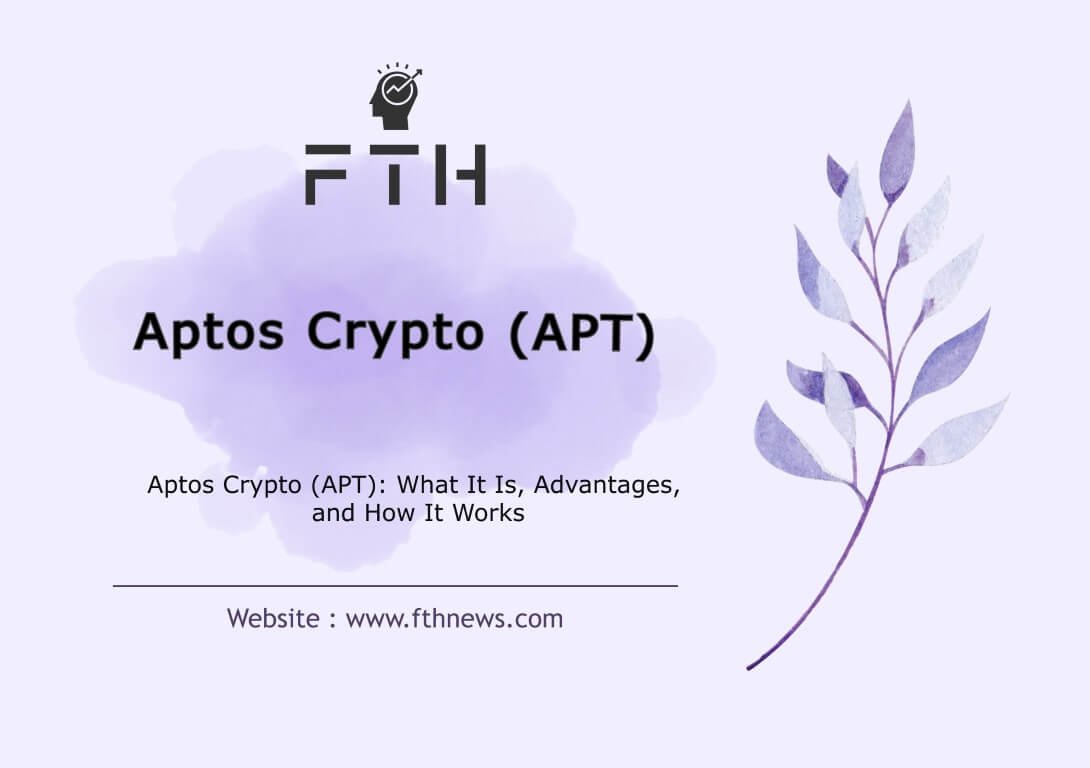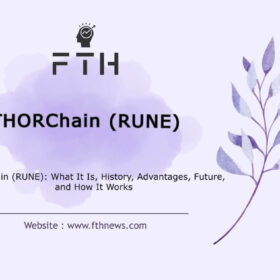
Aptos Crypto (APT): What It Is, Advantages, and How It Works
In the ever-evolving landscape of digital currencies, a plethora of projects vie for attention, each touting unique advantages and features. Aptos Crypto (APT), has emerged as a notable player in the fintech domain, making significant waves. As the financial realm undergoes decentralization and digitization, gaining insights into platforms like Aptos becomes imperative.
Understanding Aptos Crypto (APT)
At its core, Aptos stands as a first-layer blockchain, distinguished by its use of the Move programming language. Conceptually, it positions itself as the successor to the Dim Meta blockchain project. The foundational tenets of the Aptos digital currency blockchain rest on scalability, security, and upgradeability. With groundbreaking concepts in consensus mechanisms, performance optimization, system security, and smart contract design, Aptos aims to revolutionize the landscape of first-layer blockchains.
The overarching objective of the Aptos project is to establish infrastructure akin to the centralized cloud infrastructure of Web 2.0, but in a decentralized manner. This strategic move aims to facilitate the wider adoption of Web 3.0 by constructing a pervasive blockchain. Simultaneously, Aptos endeavors to forge a decentralized ecosystem capable of addressing real-world challenges.
What is Aptos Crypto (APT) ?
Functioning as a layer 1 blockchain, Aptos employs a proof-of-stake (PoS) consensus mechanism, aligning itself with major players like Bitcoin, Ethereum, and Cardano. The question arises: in a domain already dominated by such stalwart blockchains, why does Aptos, with its layer 1 approach, stand out? Is there still room for competition among these industry giants?
Aptos cryptocurrency blockchain sets its sights on the realm of Web 3.0, marking a significant technical breakthrough in the landscape of layer 1-based projects. Often referred to as the “New Internet,” Web 3.0 encompasses all economic services, products, and applications constructed on blockchains. This diverse array includes DeFi applications, NFTs, GameFi, Play-to-Earn (P2E) games, and various other cryptocurrencies.
Note: Please let me know if you’d like any specific information added or if there are particular aspects you’d like emphasized in the subsequent parts of your blog post.
Aptos Crypto (APT) History and the Team
In our exploration of Aptos, let’s uncover the project’s journey and the brilliant minds behind its development. Aptos officially launched on October 12, 2022, marking the culmination of three years of intensive development. Shortly thereafter, on October 17, the main blockchain network, Aptos Autumn, made its debut.
At the forefront of Aptos are Mo Shaikh and Avery Ching, the dynamic duo from Aptos Labs. Bringing their expertise as former Meta programmers, Shaikh assumes the role of CEO, while Ching serves as CTO. Alongside a dedicated team of designers, engineers, researchers, and strategists, they’re steering Aptos towards success.
Aptos started as a modest team that swiftly garnered attention, securing approximately $200 million in its initial investment round. Key contributors to this substantial funding include Three Arrows Capital, FTX Ventures, Paxos, and Coinbase Ventures. This financial backing empowered Aptos to expand its team, implement groundbreaking ideas and technologies, and offer support to Aptos pro-developers.
Despite its relative newcomer status, Aptos made a significant impact with early releases and a well-executed airdrop, cementing its position in the crypto community. This not only underscores the project’s unique attributes but also reflects the strategic foresight of its development team.
the Mechanisms: How does Aptos Crypto (APT) work?
To understand the inner workings of Aptos, let’s delve into its consensus mechanism, validators, and the programming language that powers its operations.
Consensus Mechanism: Aptos Blockchain
Aptos operates on a proof-of-stake (PoS) blockchain employing an advanced Byzantine Fault Tolerant (BFT) consensus mechanism. This mechanism collaborates with a group of validators, collectively responsible for receiving, processing, and validating transactions.
Unlike conventional consensus protocols that adhere strictly to transaction order, Aptos takes a unique approach by running two processing processes in parallel. This parallel execution significantly reduces the latency in transaction verification, enhancing overall speed. The Byzantine fault tolerance engine meticulously analyzes each state in the validation chain, automatically updating validations when necessary to ensure accuracy.
BlockSTM Technology
Aptos integrates BlockSTM technology to efficiently manage smart contracts. This technology creates a multi-threaded, in-memory parallel engine, boosting the Aptos blockchain’s transaction processing capabilities. The ability to process transactions in parallel is crucial for scalability and achieving high throughput.
Simultaneous transaction processing enhances operational speed, with errors in individual transactions isolated, preventing them from affecting the entire process. Aptos optimizes this process by prioritizing specific transactions for efficient validation. As a result, Aptos boasts a remarkable capacity to process over 160,000 transactions per second.
The network’s infrastructure ensures atomic processing of all transactions, laying the foundation for secure peer-to-peer transactions without relying on intermediaries.
Move Programming Language
Aptos relies on the “Move” programming language, an object-oriented model, to represent its ledger’s state. Move, originally designed for Meta and intended for projects like Libra digital currency and Dim blockchain, is a relatively new programming platform for blockchain, smart contracts, and other applications.
Move’s sophisticated smart contract language is touted by the Aptos team for facilitating fast and secure transactions, as well as streamlining blockchain and smart contract auditing and analysis. Consisting of a compiler, a virtual machine, developer tools, and a verifier (Move Prover), the language ensures program correctness. Its flexibility allows developers to tailor it to Aptus’ unique requirements. Move, based on the Rust language, focuses on controlling resource access, preventing the creation of invalid coins, and safeguarding against double-spending.
Configurability and Upgradeability
A standout feature of Aptos digital currency is its configurability and upgradeability. The modular design of Aptos permits meticulous testing of the network and modeling of potential threats, ensuring robust security. The Move programming language further equips Aptos with the frameworks needed to advance blockchain and implement broader Web 3.0 applications.
Aptos Crypto (APT) Tokenomics
At the heart of the Aptos ecosystem lies its native digital currency, the APT token, with its smallest denomination known as Octa. While the total supply of APT tokens has no defined cap, the initial supply was set at approximately 1 billion units during the launch of Aptos in October 2022. As of now, the circulating supply has surpassed 162 million units.
The initial release of the APT token wasn’t without controversy. The Aptos developers launched it without initially disclosing details about its release mechanism and the overall distribution plan to the Aptos community. In response to the community’s strong reaction, the Aptos development team later released more comprehensive information about the supply and allocation of this digital currency.
Token Allocation Breakdown
As per Aptos project disclosures, of the initial supply of one billion APT tokens, allocations were distributed as follows:
- Community: 51.02%
- Foundation: 16.5%
- Main Participants: 19%
- Investors: 13.48%
In a detailed blog post, the Aptos team outlined that the allocation to the “community” category includes incentives and financial support for Aptos community growth plans. Presently, some of these tokens are assigned to projects built on the Aptos protocol, with eligibility for rewards upon completing their key milestones. The majority of these tokens are held by the Aptos Foundation, and a smaller portion is maintained by Aptos Labs. The plan is for these tokens to be distributed over a 10-year period.
Locking Period for Investors and Contributors
Investors and original contributors are subject to a four-year token lockup period, excluding rewards received from these tokens. The lockup period commenced from the main network’s launch date on October 12, 2022. As of now, a significant 82% of the circulating supply of APT tokens is staked, highlighting a strong commitment from the investor and contributor community.
This intricate economic structure underscores the Aptos team’s commitment to community involvement, strategic development, and long-term sustainability.
Airdrop of APT Tokens:
In a strategic move to foster community engagement, the Aptos project initiated its first airdrop, distributing a total of 20,076,150 APT tokens to 110,235 eligible addresses. This airdrop represents 2% of the total initial supply, with the Aptos Foundation expressing its commitment to exploring additional opportunities to support the growing Aptos community in the future.
Distinguishing Features of Aptos Digital Currency
Despite its relatively recent introduction to the crypto space, Aptos has swiftly garnered attention and venture capital interest. Several distinguishing features set Aptos apart from its counterparts:
- Aptos Team’s Skill and Expertise: The Aptos team, comprising successful engineers and developers with a background in the Diem project, brings a wealth of experience to the table. This collective expertise instills confidence in the reliability of the Aptos project.
- Exciting Solutions: Aptos promises a trifecta of speed, scalability, and security. The commitment to ongoing upgrades positions Aptos as a dynamic player in the ever-evolving crypto landscape.
- Unique Architecture: Aptos boasts a modular design, facilitating the seamless integration of new Web 3.0 technologies and features. This architecture contributes to the project’s adaptability and agility.
- Private Key Recovery Solution: Addressing a common challenge in the crypto space, Aptos offers a solution for users who may forget their passwords or recovery phrases. This feature enables secure recovery of private keys, preventing permanent loss of digital assets.
- Experienced Project Founders: The founders of the Aptos project play a pivotal role in attracting investors and venture capital firms. Their extensive experience in developing blockchain projects and fostering constructive investor relations adds credibility to the project.
Contributing Factors to Aptos’ Growth
Several factors have fueled the notable growth of Aptos since its launch:
- Venture Capital Funding: Aptos secured a substantial $350 million in funding with support from prominent venture capital companies, including Andreessen Horowitz, FTX Ventures, and Jump Crypto.
- Binance Support: Aptos received strategic investment and support from Binance, a significant player in the cryptocurrency exchange landscape.
- Ecosystem Sustainability: The commitment to sustainable ecosystem development underscores Aptos’ long-term vision and viability.
- UpBit Exchange Interest: Notably, South Korea’s UpBit exchange has witnessed significant interest in purchasing APT, constituting 40% of Aptos’ trading volume. However, caution is advised, as this surge may be influenced by potential laundering transactions, leading to a false price increase.
Aptos’ multifaceted approach, coupled with strategic partnerships and community-focused initiatives, positions it as a dynamic player in the competitive cryptocurrency landscape.
Aptos Digital Currency Competition
Despite its impressive features, Aptos faces competition from established players in the blockchain arena. Let’s explore how Aptos compares to its formidable competitors and the distinctions that set it apart.
Aptos vs. Solana
Termed as “Solana’s killer,” Aptos positions itself against Solana, a leading tier 1 blockchain. While both Aptos and Solana exhibit similar processing speed, with parallel calculation engines, Aptos edges ahead in terms of reliability. Solana has encountered network outages and issues, contributing to a perception of lower reliability. Aptos addresses this with a redundancy scale, ensuring network availability by synchronizing nodes and employing pioneer nodes. This redundancy, while efficient, demands more computational power and robust hardware compared to Solana. Aptos appears to offer enhanced reliability, but as a newer project, it needs to sustain its performance over time to surpass Solana definitively.
Aptos vs. Ethereum
In transaction processing speed, Aptos outpaces Ethereum significantly. While Ethereum may take over a minute to finalize a transaction, Aptos accomplishes this in less than a second. However, Ethereum maintains a higher level of reliability, given its stable performance over time. Despite its gas fees and longer transaction times, Ethereum’s established track record presents a considerable challenge for competitors like Aptos.
Aptos vs. Olench
Aptos exhibits superior performance compared to Olench under optimal test conditions. While Olench may boast a slight edge in transaction finalization speed on paper, Aptos performs more effectively in real-world scenarios. Aptos surpasses Olench in transaction processing per second (TPS), with a range of 130,000-160,000 TPS compared to Olench’s 4,500 TPS.
Moreover, Olench grapples with significant gas-related issues, particularly as transaction volumes surge, especially in NFT games. Aptos, in contrast, avoids such complications through its unique storage method based on the Move programming language. This approach enables users to group multiple items together, minimizing costs and sidestepping the gas-related challenges faced by Olench.
In conclusion, while Aptos competes with these blockchain giants, its unique features and performance advantages position it as a formidable player in the dynamic digital currency landscape. Sustaining its strengths over time will be pivotal in securing its position among these competitors.
Advantages of Aptos Digital Currency Network:
As with any cryptocurrency project, the Aptos network presents distinct advantages and disadvantages, catering to specific investor preferences. Understanding these strengths and weaknesses is crucial for informed decision-making. Here’s an overview:
High Speed: Aptos boasts impressive transaction processing speed, providing users with swift and efficient transactions.
Excellent Security: The Aptos network prioritizes security, leveraging advanced technologies to ensure the protection of user assets and data.
Decentralized Structure: With a decentralized architecture, Aptos operates without reliance on a central authority, fostering a more resilient and censorship-resistant network.
Unique Technologies: Aptos introduces unique technologies, setting it apart from traditional blockchain solutions and offering innovative solutions to common challenges.
Smart Contract Support: The network supports smart contracts, enabling the execution of self-executing contracts with predefined conditions.
Small Fees: Aptos features a fee structure that is conducive to cost-effective transactions, enhancing its appeal to users.
Coherent Token Economy: The tokenomics of Aptos are designed coherently, aligning with the overall goals of the project and providing a solid foundation for its digital currency.
And More: Additional strengths contribute to the overall appeal and functionality of the Aptos network.
Disadvantages of Aptos Network and Digital Currency:
Being Unknown Among Users and Investors: Aptos may face challenges in terms of recognition and awareness among potential users and investors, impacting its market presence.
Experimental Nature: A notable portion of the technologies and capabilities of the Aptos blockchain is experimental. While this reflects innovation, it also introduces an element of uncertainty regarding their widespread adoption and performance in real-world scenarios.
Understanding both the advantages and disadvantages empowers potential investors to make informed decisions based on their preferences and risk tolerance. The dynamic nature of the cryptocurrency space suggests that ongoing developments and community engagement will play a crucial role in shaping the trajectory of the Aptos network.
Understanding the APT Token in the Aptos Ecosystem
The APT token is the native digital currency of the Aptos platform, identified by the symbol APT. This cryptocurrency serves multiple purposes within the Aptos network:
1. Transaction Fee Payment:
- APT is utilized to pay transaction fees on the Aptos platform, ensuring the smooth processing of transactions within the network.
2. Sovereign Token:
- APT is a sovereign token, granting its holders the ability to voice their opinions and contribute ideas to the development and activities of the Aptos network.
3. Proof of Stake (PoS) Security:
- The Aptos digital currency plays a crucial role in securing the blockchain through the Proof of Stake (PoS) algorithm.
4. Validator Participation and Rewards:
- APT token holders can actively participate in validating transactions on the Aptos network. Validators, a defined group within the network, process transactions and receive rewards for their efforts.
5. Stake Token Contribution:
- Apart from validators, other APT cryptocurrency holders can join in the validation process by staking their tokens. This involves using their APT holdings to contribute to the processing of transactions.
6. Reward Distribution:
- Rewards earned from processing transactions are distributed between validators and APT cryptocurrency stakers. This mechanism encourages active participation and engagement within the Aptos network.
7. Maximum Bonus Rate for Stake:
- Currently, the Aptos network sets a maximum bonus rate for stakeholders at 7% annually. This rate represents the reward potential for those actively contributing to the network’s security and transaction processing.
In essence, the APT token is more than just a medium of exchange; it serves as a fundamental component of the Aptos ecosystem, aligning the interests of token holders with the network’s development and security.














